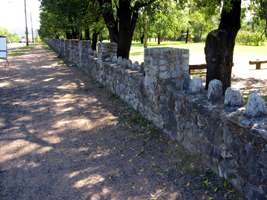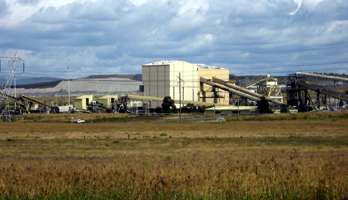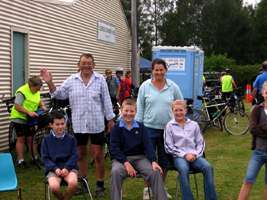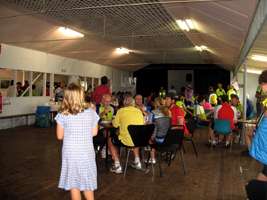Back to Don's Maps
Big Bike Ride - Escapade 08
Click on the photos to see an enlarged version
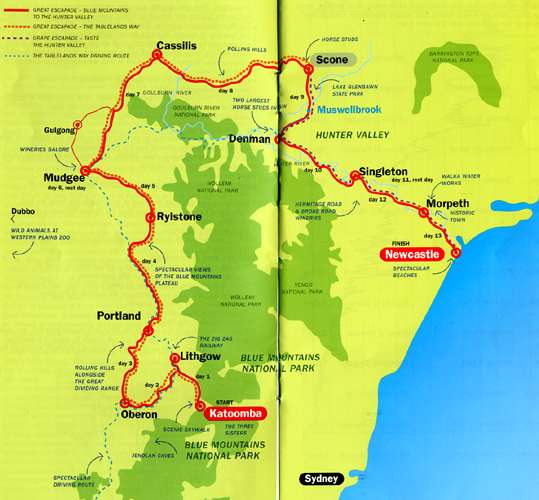
The route
Photo: Bicycle Victoria
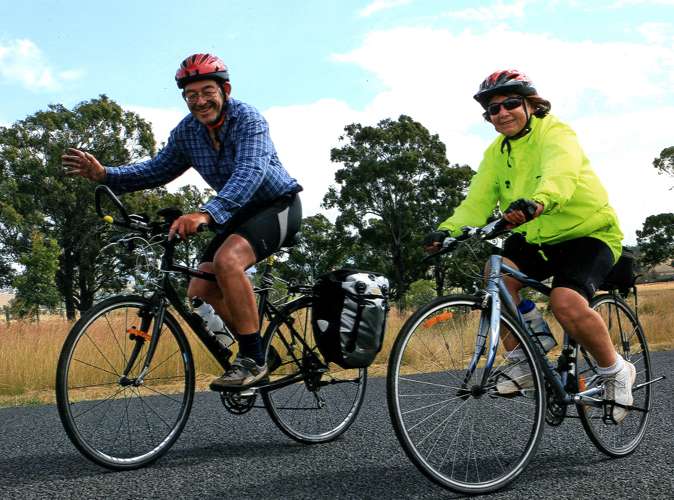
This photo and text appeared in the local papers in Armidale after we returned from the ride.
Local residents, Don and Maria Hitchcock have just returned from the Great Esacapade, a 729 km bicycle ride over 13 days through the Blue Mountains and Hunter Valley organised by Bicycle Victoria and Bicycle NSW. The ride attracted about 1300 cyclists and started at Lithgow on Saturday 29th March. From there they rode to Oberon, Portland, Rylestone, Mudgee, Cassilis, Scone, Denman, Singleton, Morpeth and Stockton Beach at Newcastle.
The ride was fully supported with catering, transport of luggage, medical services, mechanics and police support. Riders camped in showgrounds or sporting grounds and shower and toilet trucks accompanied the ride from start to finish. It's a mammoth organisation and very complex to set up. Preparations start over a year beforehand for any individual ride as towns and routes are searched out and negotiated well ahead of time.
This was the 5th Big Ride for Maria and Don but it was by far the most challenging. The hilly terrain day after day was relentless and quite exhausting. Apart from that many of the road surfaces were very rough slowing riders down substantially. There were strong head winds most days and frosty nights which covered tents with ice. Each day's ride was quite long with two days over 100 kms. Two well-needed rest days were had in Mudgee and Singleton to recharge the batteries ready for the next stretch.
The physical hardships were soon forgotten each night as the social side of the ride kicked in. Riders came from all over Australia and overseas and a large marquee with long tables ensured that everyone mixed and shared stories. Entertainment was provided each night with a local singer or band, a film, a talent quest, trivia night and the daily briefing.
As the ride was supporting the MS society, much fundraising took place. The best events were the shave off of the Pegasus crew and the waxing of the police. This was a chance to tear strips off a policeman for a price, naturally. Needless to say, the fundraiser was well supported. Riders were also treated to the officer in command of the northern section playing the bagpipes, again for a fee. A few wags paid him not to play but they lost out.
Maria and Don train regularly with an 18 km ride most mornings. Both have road bikes although some of the riders on the Great Escapade rode everything from mountain bikes, tandems, recumbent bikes and tagalongs. Next year they hope to participate in the next Great Escapade beginning at Margaret River in WA. For more information on the next ride, go to Bicycle Victoria's website, www.bv.com.au.
Photo: Professional Photographers, Great Escapade 08
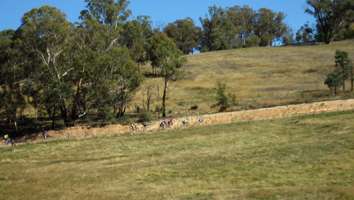
Toiling up the hill.
Photo: Maria Hitchcock 2008
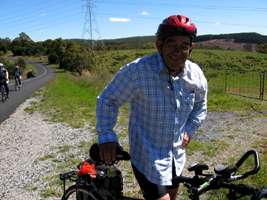
Stopped for a drink of water.
I bought a set of cotton long sleeved shirts for the ride, since I find that they work better for me than the standard jerseys. They provide sun protection for my arms but allow good ventilation, especially on hot days when I open the front up, and they dry reasonably quickly after washing.
Photo: Maria Hitchcock 2008
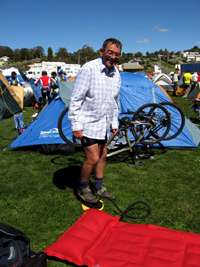
At camp, pumping up the lilos, or air mattresses. The pump gave up on the second day, and I had to pull it apart and reseat the yellow plastic bellows, which worked well.
Photo: Maria Hitchcock 2008
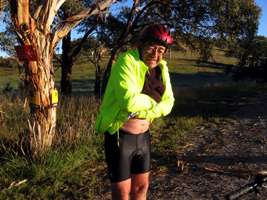
We had big frosts for five days in a row, and the only way I could unfreeze my hands while riding was to put them on my bare skin.
Photo: Maria Hitchcock 2008
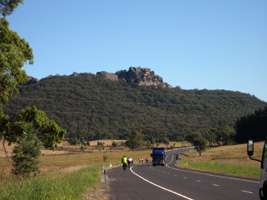
We were gradually leaving the Blue Mountains by this stage, but there were still isolated examples of beautiful cliffs.
On main highways we tried to use the sides of the roads if they were available, to avoid getting too close to the traffic.
Photo: Maria Hitchcock 2008
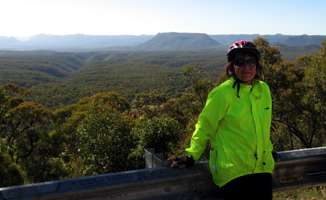
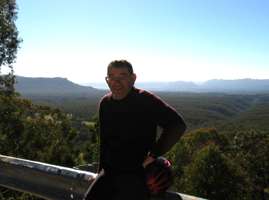
Pearson's Lookout, after a long pull up the hill.
Photo: Maria Hitchcock 2008
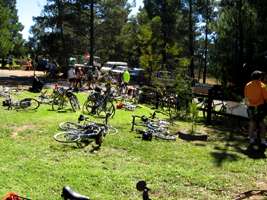
There were water/rest stops about every twenty to thirty kilometres, a longer distance than the big bike rides organised by Bicycle NSW. The water truck in the background had a small electric pump which kept good pressure for the water spigots.
Photo: Maria Hitchcock 2008
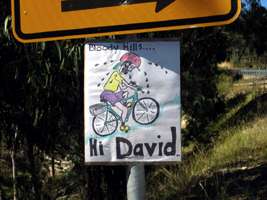
A delightful feature of part of the ride were these messages to various riders from their friends amongst the "vollies" or volunteers who help the whole trip work by serving food, standing on cold and windy corners directing the riders, driving trucks and a myriad of other tasks.
Photo: Maria Hitchcock 2008
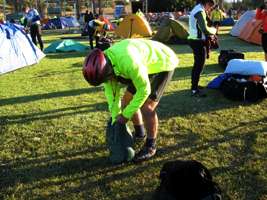
Packing the frozen ice covered tent fly into the bag. My hands were frozen as well after this task! Often there was still ice on the fly when we unpacked it at the end of each day's riding. We put the four 10 kg pieces of luggage on the truck each morning, only keeping out what we needed during the day's ride.
Photo: Maria Hitchcock 2008
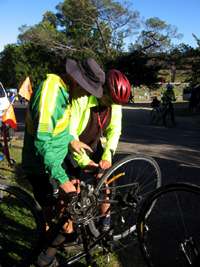
I had just got on my bike when I realised I had a flat tyre. It turned out to be a piece of broken glass which had worked its way through the tyre and tube. We carry spare tubes to make the repair process as fast as possible. In this case I was able to call on the services of a WARBY (We Are Right Behind You) volunteer to help fix the flat. WARBYs are a big help on the ride, and if anything major needs fixing, there are professional bicycle mechanics at every stop and at the end of the ride to make repairs.
Photo: Maria Hitchcock 2008
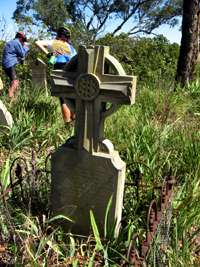

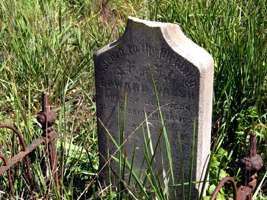
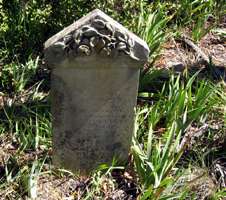
This was a private cemetery by the side of the road, for the Walsh family. Most of the graves were more than a century old.
Photo: Maria Hitchcock 2008
Information about Mudgee in italics below from http://www.walkabout.com.au/locations/NSWMudgee.shtml
Mudgee' reputedly derives from the Wiradjuri Aboriginal term 'Moothi' meaning 'nest in the hills'. This is a suitable title as Mudgee is an attractive town of fine old buildings, located in the broad, picturesque and fertile Cudgegong River Valley. Surrounded by hills of green and blue, it is situated 265 km north-west of Sydney, 470 m above sea-level and has a current population of around 8200. The area is noted for its fine wool, beef, fat lambs, cereal crops, lucerne, vegetables, vineyards and honey. There is also a coal mine at Ulan, a large export abattoir, a livestock exchange and numerous horse, sheep and cattle studs.
The first European in the immediate vicinity was James Blackman who headed north to the Mudgee area from what is now Wallerawang in 1821, becoming the first European to cross the Cudgegong River. It is known that he had a slab building on the townsite by 1837.
Once Blackman proved the route passable William Lawson, who had failed in an earlier attempt, travelled north to Mudgee where he found some excellent grazing land. Lawson had been a member of the first European party to cross the Blue Mountains in 1813 and was then commandant of Bathurst. He later took up 6000 acres along the Cudgegong River.
He was immediately followed by George and Henry Cox (sons of William Cox who built the first road over the Blue Mountains) who became the first permanent European settlers on the Cudgegong River when they established the 'Menah' run, 3 km north-west of the present townsite. It was here that the first settlement developed. A police station and lock-up were established in 1833.
Prior to that time the district had been occupied by the Wiradjuri people. Relations were amicable when white numbers were negligible but, as settlement escalated in the 1820s, conflict increased. Kangaroos and possums, major food sources, were slaughtered wholesale by whites. Sacred sites were desecrated and prime riverside land was taken. In 1824 martial law was declared and armed settlers roamed the countryside murdering Aborigines on sight, thereby decimating the tribe which was dispossessed and completely broken by the 1840s. William Cox, who made a significant contribution to their extermination, claimed the last local black died in 1876.
The village of Mudgee was gazetted in 1838. By 1841 there were 36 dwellings, mostly of slab construction, including three hotels, a hospital, a post office, two stores and the first Anglican church. The first school (Anglican) was established in a slab hut in the 1840s and the police station was moved from Menah to Mudgee in the mid-1840s. The population had only reached about 200 by 1851.
However, a goldrush began when a huge nugget was found at Hargraves in 1851. Mudgee became a centre for the local goldfields, benefiting considerably from the consequent through-traffic which peaked with the finds at Gulgong and Hill End at the beginning of the 1870s.
It is a sign of Mudgee's early success that the population increased to 1500 by 1861 and it was declared a municipality in 1860, making it the second-oldest town west of the Great Dividing Range. Methodist and Presbyterian churches, the present Catholic and Anglican churches and the first National school were all built in the 1850s. In addition a police station, courthouse, post office, mechanics institute, the present Uniting Church and a town hall were added from 1860 to 1865. There were four coach factories operating in the 1860s to cater for the overwhelming transport demands.
Fortunately, Mudgee was not just dependent on gold. The immediate area became noted for its quality wool and merino studs, its vineyards (introduced by a German immigrant in the 1850s) and its agricultural production. When the gold began to peter out late in the 19th century it was the strength of these staples which sustained the town. When the railway arrived in 1884, it further boosted agricultural sales.
One of Australia's most famous poets and short-story writers, Henry Lawson (1867-1922), had very strong ties to Mudgee. His parents were married here in 1866. But for a brief stay at Gulgong, he was raised, from the age of six months to 15 years, in a cottage 8 km north at Eurunderee which was established after a gold find in 1863. Lawson was educated at Eurunderee and Mudgee and many of his stories are inspired by his memories of the area.
The historical information below about Mudgee comes from "Mudgee Walks", a brochure for a self guided tour of Mudgee prepared by the Mudgee Historical Society, Colonial Inn Museum, 126 Market Street, Mudgee NSW 2850 Australia.
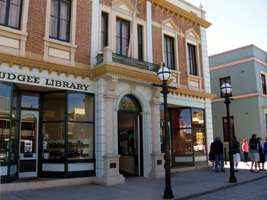
The Town Hall, now the Town Library, was built in 1880, and is classified by the National Trust. The lamp posts were designed to carry gas lamps.
Photo: Maria Hitchcock 2008
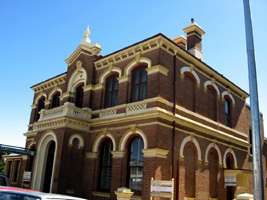
Professional Offices, Market Street. This two storied building was the National Australia Bank, erected in 1884, and is classified by the National Trust.
Photo: Maria Hitchcock 2008

Mudgee is a former gold mining town, and shows evidence of its former wealth in the many beautiful well constructed and architect designed buildings.
Photo: Maria Hitchcock 2008
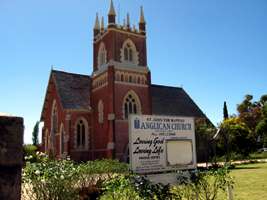
This Church is a lovely addition to the architecture of the town.
The St John the Baptist Church of England, classified by the National Trust, was completed in 1861, replacing the original building of 1841. It has some fine stained glass windows. In 1966 extensive restoration was carried out on the Brindly and Foster organ which was installed in 1881, donated by R.H.D. White along with the bell.
The organ is one of the largest to be found outside a cathedral. The earlier organ was given to the Presbyterian Church.
Photo: Maria Hitchcock 2008
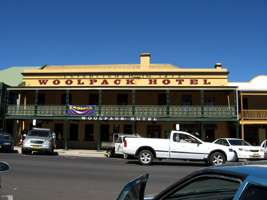
The hotel is a prominent feature of most old towns in Australia, and Mudgee is no exception.
The Woolpack Hotel (1873) pictured here shows the classic verandah and iron lace of many country pubs. It has been lovingly restored to its former glory.
Photo: Maria Hitchcock 2008
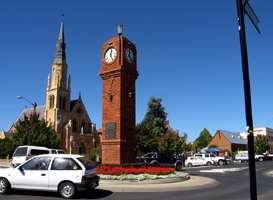
The clock and tower in the foreground were donated to the community by Mr Ivan Adams as a War Memorial.
Behind the tower is St Mary's Roman Catholic Church, Presbytery and Convent. The Presbytery, built in 1851 and the church are both classified by the National Trust.
Photo: Maria Hitchcock 2008
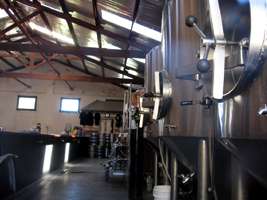
This is a small boutique brewery in Mudgee.
Photo: Maria Hitchcock 2008
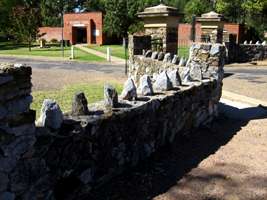
Stone Wall around Lawson Park, Mudgee.
This is without doubt the worst public stone wall I have ever seen. It was poorly conceived, poorly executed, (lately, poorly and far too obviously repaired), on poor foundations, and now leans like a drunken sailor and is about to topple over along much of its length.
The best thing you can say for it is that being built in 1932, it provided much needed employment at the time, but it would have been better to provide even more employment and knock it down immediately after completion, and get a qualified and experienced stone mason to design and supervise the erection of a well conceived wall with solid foundations.
If they had taken the trouble to make solid foundations, made the wall a little higher, and made the piers into proper piers instead of just steps in the wall (that is, made the piers wider as well as a little taller than the wall, not lookout towers) and not even thought about those nightmare inducing sharks' teeth or tomb stones on top, they might have had a stone wall to be proud of.
Photo: Maria Hitchcock 2008
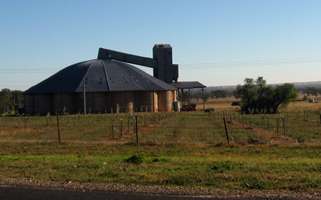
A grain storage silo on the way out of Mudgee.
Photo: Maria Hitchcock 2008
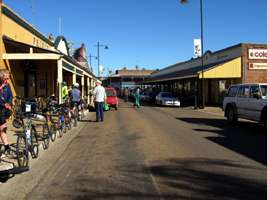
One of the main streets of Gulgong. It was good to find a cafe to warm up and have some good coffee after a very cold morning on the bike between Mudgee and Gulgong. Many other riders had the same idea.
Photo: Maria Hitchcock 2008
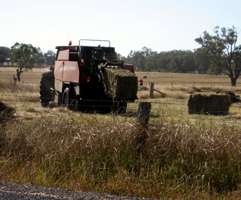
All the automatic hay balers I've seen have been ones which put out round bales. This one puts out rectangular bales, which stack in a smaller volume.
Photo: Maria Hitchcock 2008
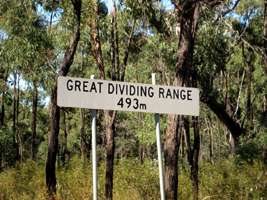
Here we crossed the Great Dividing Range, and entered the catchment of the Hunter River.
Photo: Maria Hitchcock 2008
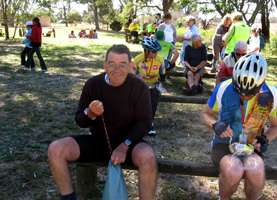
Lunch at a school on the way, just about to open my silnet bag containing coffee making tools. I carried a propane stove and billy and finely ground coffee to make my turkish coffee every day at morning tea and lunch. Some things are essential, and turkish coffee is a part of my ritual each day.
Photo: Maria Hitchcock 2008
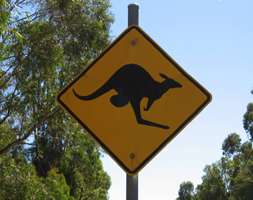
A subtly altered sign advertising the presence of macho kangaroos. You have been warned!
Photo: Maria Hitchcock 2008
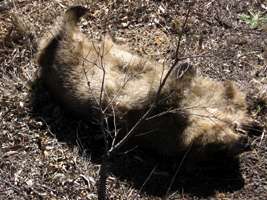
A wombat by the side of the road. They make a mess of any ordinary car which hits them.
Photo: Maria Hitchcock 2008
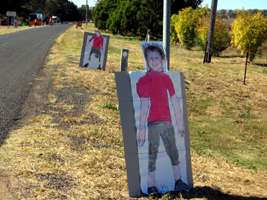
It was great to see these welcoming signs along the road as we approached the camp site.
Photo: Maria Hitchcock 2008
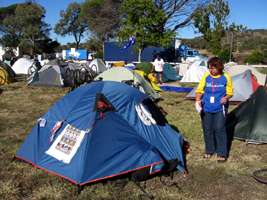
We used the tent to dry clothing after washing.
Photo: Maria Hitchcock 2008
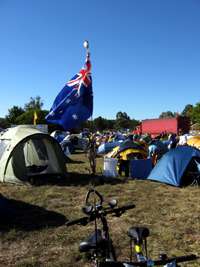
I made up this flagpole using a cheap child's fishing rod, a small flag, and a little flashing light meant for a bike on top so we could find the tent easily. It worked brilliantly, except late one night after the overhead sports ground lights were out and I forgot to turn it on before going to the toilet truck...
Photo: Maria Hitchcock 2008
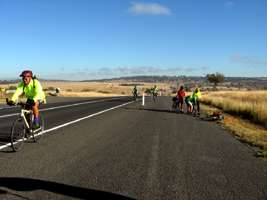
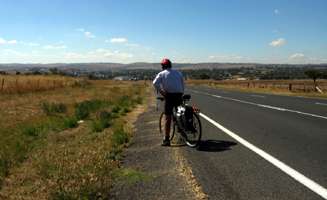
There was a very long climb out in the morning. Long climbs of several kilometres were a feature of this ride.
Photo: Maria Hitchcock 2008
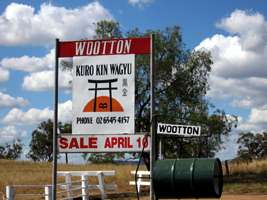
Some of the beef cattle properties in the area cater specifically for the Japanese beef trade.
Photo: Maria Hitchcock 2008
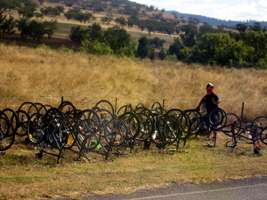
The ride on this day was 108 kilometres, and at the lunch spot at the 72 km mark, I did my sums and found that we would not get to the camp site until seven or eight pm, long after the ride was due to finish for the day. About 250 others came to the same decision, so a bus made several shuttle trips with riders, who left their bikes upside down on the side of the road to be picked up by a truck later and taken to the camp site. The irony is that we had done a 102 km ride the day before, and found it a breeze. The difference was the road profile, which on this day was up and down like a yo-yo. The mathematics is such that you can't make up for slow speed going up the hill by going fast down the other side.
Photo: Maria Hitchcock 2008
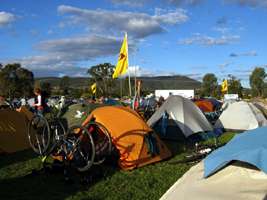
Most tents used by the riders are of the igloo type. They are quick and easy to put up. The flags denote areas for volunteers, general camping and quiet camping - but the last two areas pretty much merged.
Photo: Maria Hitchcock 2008
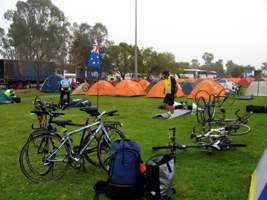
I fixed the flag pole to our bikes to give more height. Rain swept the camp site regularly at this point, making conditions sodden. The orange tents in the background were for the volunteers. Many of them leaked in the heavy rain we had during the trip, but our Macpac tent from NZ was as always totally waterproof. It is an ideal tent for these conditions, with enough room in the vestibules for all our gear, and a tub floor for really wet conditions. It is a dream to put up and peg down. You need reliable equipment on trips like this.
Photo: Maria Hitchcock 2008
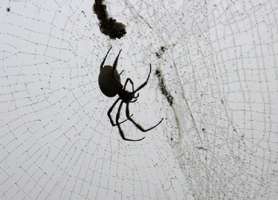
The next morning was cool and wet, and Maria took the opportunity to photograph this spider making its web in the misty rain.
Photo: Maria Hitchcock 2008
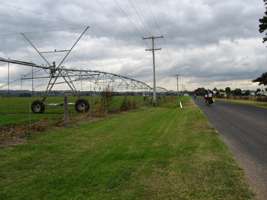
We were now in the Hunter River valley, an area with a prodigious amount of irrigation. This huge boom, tethered at the far end, travelled in a semicircle to water crops. Each of the vertically hanging black pipes had a sprinkler.
Photo: Maria Hitchcock 2008
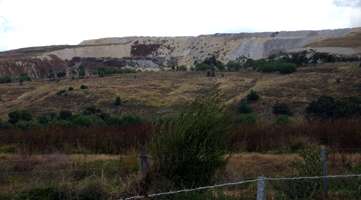
The ride should have been billed as a tour of coal mine areas. Anyone in any doubt about the economic importance of coal to Australia should take a trip along these roads. Huge coal mines lined the route at times, and massive pieces of equipment on oversize trucks and low loaders passed us constantly.
Photo: Maria Hitchcock 2008
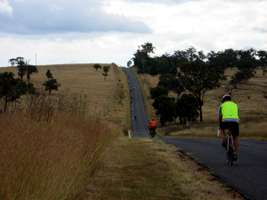
One of the few remaining long, long hills on the route. We were now entering much flatter country.
Photo: Maria Hitchcock 2008
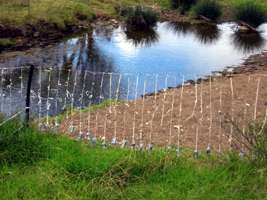
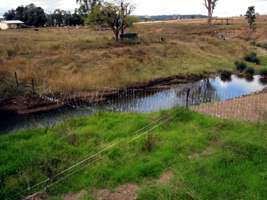
This is a delightful and creative way of making a cattle fence across a creek. Aluminium cans were attached by very visible cord to a wire going across the creek, itself wrapped with the white cord. The vertical cords had loops knotted in them to further increase visibility and presumably the effectiveness of the barrier.
Photo: Maria Hitchcock 2008
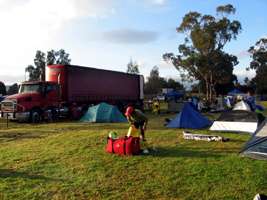
As well as the ubiquitous igloo tents with two poles, there were also "hoop" tents with many poles, and single pole types, these last are a type mostly used by bushwalkers because of their low weight and volume.
The large red truck transported our luggage from one campsite to the next, meaning that we only had to carry with us what we were likely to need while on the road.
Photo: Maria Hitchcock 2008
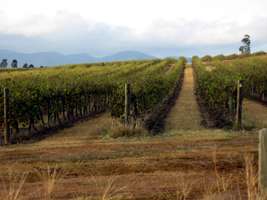
Vineyards were everywhere, stretching to the horizon over many hundreds of hectares at times. The Hunter Valley is a big export earner, and the vineyards are one of the most ecologically friendly methods of agriculture, producing value added products for the export trade.
Photo: Maria Hitchcock 2008
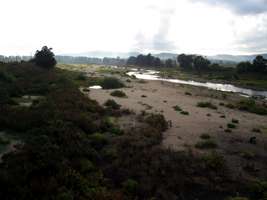
Although there were good rains in other parts of NSW over the previous summer, this area was feeling the effects of not enough precipitation. This river was barely flowing.
Photo: Maria Hitchcock 2008
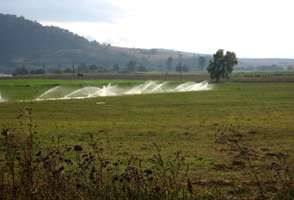
The Hunter Valley is dependent on irrigation, often from bores and wells, for its productivity.
Photo: Maria Hitchcock 2008
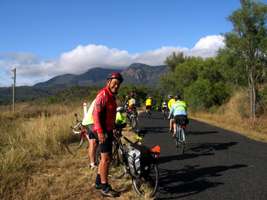
This was a cool and short day, with few hills, so I wore my "proper" bike riding jersey. They are rarely flattering to middle aged or older men, emphasizing the waist line, not many men's strong point. In fact most bike gear only looks good on stick thin figures. Lycra and nylon hide very little from the public view, and some things are better disguised.
Photo: Maria Hitchcock 2008

A coal processing plant beside the highway. There is a coal dust fall out problem from the huge coal mine and processing activity in the area. Some residents believe it contributes to illness of various kinds.
Photo: Maria Hitchcock 2008
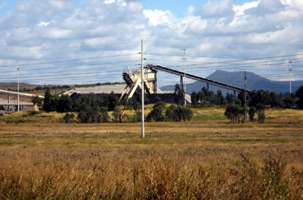
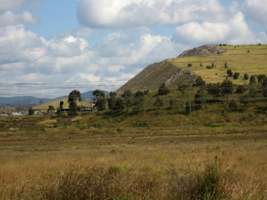
Another coal processing plant and mine beside the highway. Water is used to try to keep the coal dust problem to a minimum, which is one reason that coal mines use so much water. In addition, the mines themselves can interrupt surface water flows, further increasing water problems in the driest inhabited continent on earth.
Photo: Maria Hitchcock 2008
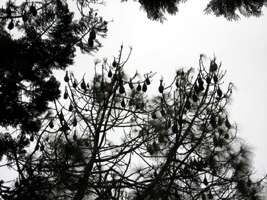
Flying foxes in the trees of a Singleton park. They spend the day hanging from the branches of the trees, then go out at night to forage.
Singleton council has so far spent more than $100,000 trying to rid the park of the bats - its most recent attempt to gain a shooting licence to cull the bats has been rejected.
Photo: Maria Hitchcock 2008
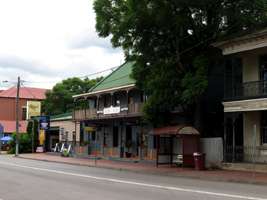
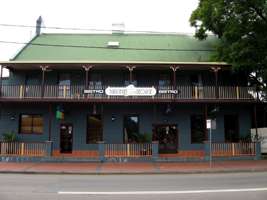
Singleton has many beautifully restored old buildings, including this pub.
Photo: Maria Hitchcock 2008
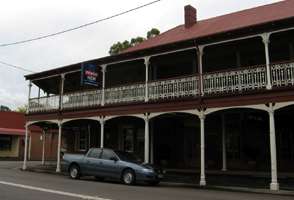
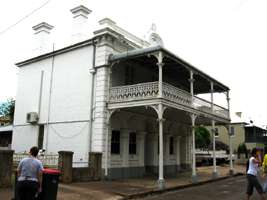
The tall posts supporting a high upper verandah and cast iron lace railings on the verandahs are features of many of the older buildings of Singleton.
Photo: Maria Hitchcock 2008
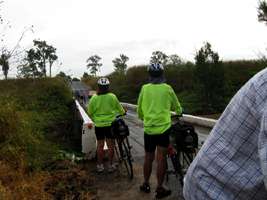
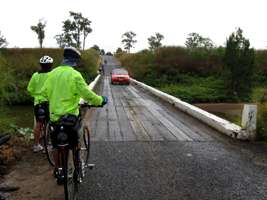
This bike eating bridge had to be negotiated by walking our bicycles across, to avoid the distinct possibility of a spill over the edge into the water below.
Photo: Maria Hitchcock 2008
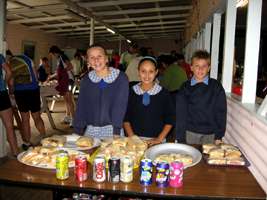
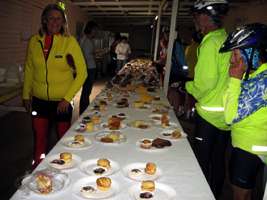
This was a very welcome morning tea stop near Branxton, put on by three primary schools in the area. The food was delicious and home made, and I hope they made a lot of money. The big bike ride can make a big difference to the finances of community groups like these.
This one in particular was extremely well organised, I have never seen such an efficient set up. There was no waiting, even though eight hundred riders descended for refreshments. An organiser told me that one of the people on the committee had been on big bike rides before, so knew what the requirements were.
Photo: Maria Hitchcock 2008
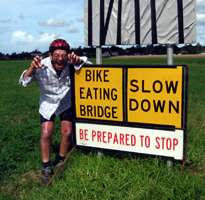
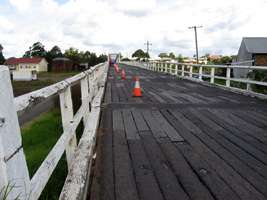
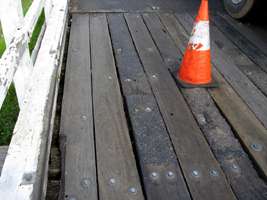
A bike eating bridge over the Hunter. In this case the organisers and police put orange witches hats on the bridge to create a bicycle lane for wheeling the bikes over, and put police at each end to control the traffic.
Photo: Maria Hitchcock 2008

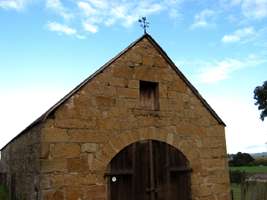
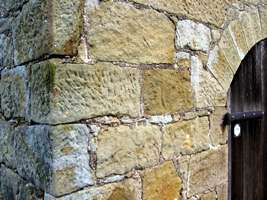
A beautifully made and maintained sandstone barn beside the road.
Photo: Maria Hitchcock 2008
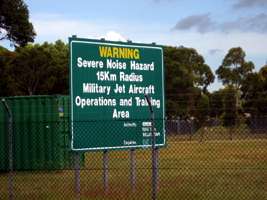


Williamtown Air Base outside Newcastle.
Photo: Maria Hitchcock 2008
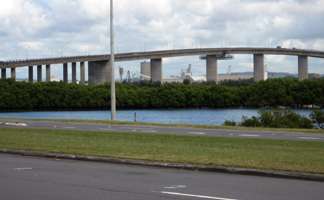
Stockton Bridge, a major crossing of the Hunter River to Newcastle from the small town of Stockton.
Photo: Maria Hitchcock 2008
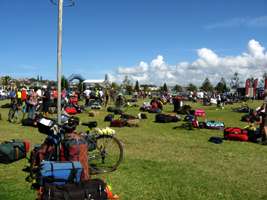
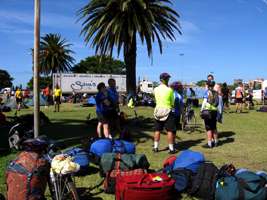
The end of the ride at Stockton.
Photo: Maria Hitchcock 2008
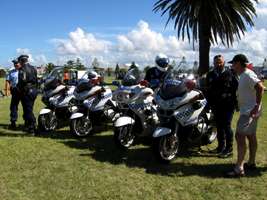
The police were a big help on the ride, calming and reorganising the traffic flow in order to create safer riding conditions.
Photo: Maria Hitchcock 2008
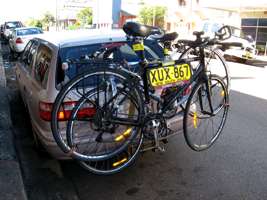
Our bicycles on the back of our car, ready for the return trip. We had a great lunch at a cafe in a Stockton arcade.
Photo: Maria Hitchcock 2008
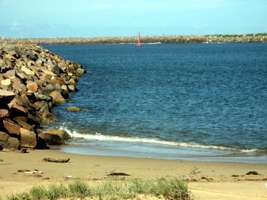
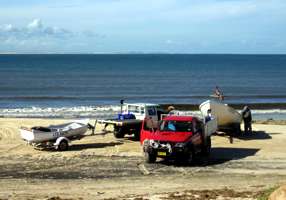
The beaches and harbours are a beautiful feature of this part of the coast.
Photo: Maria Hitchcock 2008
